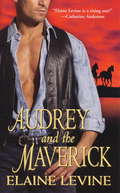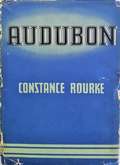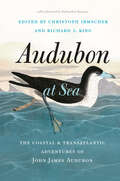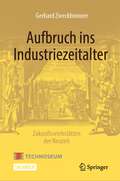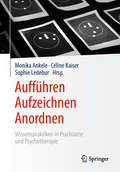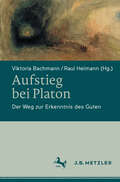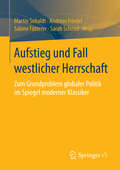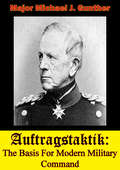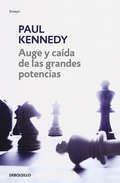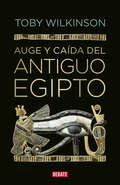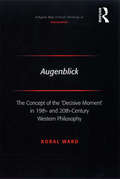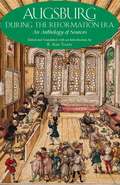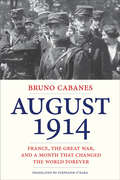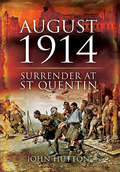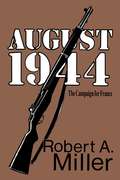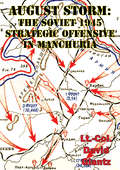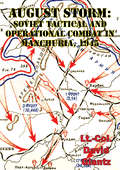- Table View
- List View
Audrey and the Maverick
by Elaine LevineIn Elaine Levine's stunning novel of the American West, a proud rancher and a determined young woman are drawn together in the lawless town of Defiance.Virginia financier Julian McCaid has put his troubled past behind him. His plans for the future don't include Audrey Sheridan, the extraordinary frontier woman he met just once. But it's because of her that he's come to the Dakota Territory to investigate problems at his ranch. And it's all the more surprising when he discovers she isn't the innocent he believed. Now nothing but her complete surrender will purge her from his soul.If it weren't for the children she cares for in her makeshift orphanage, Audrey would have left Defiance long ago. Now the sheriff is blackmailing her to distract the man who might derail his corrupt schemes--a man who can offer Audrey not just protection, but a passion bold enough to make them claim their place in this harsh and beautiful land. . .
Audrey in Paris
by Caroline YoungA charming, illustrated gift book combining two timelessly stylish subjects - Audrey Hepburn and the city of Paris.Both classic, both inimitable, both fashion icons - Audrey Hepburn and Paris are a match made in heaven. Falling in love with the city at a young age, Audrey returned to Paris again and again in some of her most celebrated films (Sabrina, Funny Face, How to Steal a Million, Charade) wearing outfits from her favourite Parisian couturier, Hubert de Givenchy, and creating some of the most significant fashion moments of the twentieth century.Audrey in Paris brings together over 100 stunning photographs of her most iconic moments in the city, from film stills and behind-the-scenes shots to candid images of Audrey enjoying the city as a visitor. The book also includes a bespoke illustrated map showing her favourite spots. While dozens of successful books on Audrey have been published, this will be the first to document her time in the city of light.Tapping into Audrey's status as a fashion idol, which spans across the generations, as well as Paris's status as the world's capital of elegance, Audrey in Paris combines the gifty charm of How to be Parisian Wherever You Are with Audrey's forever appeal as a fashion muse.Gorgeous finishes will make this a stylish gift book to be treasured for years to come.
Audrey in Paris
by Caroline YoungA charming, illustrated gift book combining two timelessly stylish subjects - Audrey Hepburn and the city of Paris.Both classic, both inimitable, both fashion icons - Audrey Hepburn and Paris are a match made in heaven. Falling in love with the city at a young age, Audrey returned to Paris again and again in some of her most celebrated films (Sabrina, Funny Face, How to Steal a Million, Charade) wearing outfits from her favourite Parisian couturier, Hubert de Givenchy, and creating some of the most significant fashion moments of the twentieth century.Audrey in Paris brings together over 100 stunning photographs of her most iconic moments in the city, from film stills and behind-the-scenes shots to candid images of Audrey enjoying the city as a visitor. The book also includes a bespoke illustrated map showing her favourite spots. While dozens of successful books on Audrey have been published, this will be the first to document her time in the city of light.Tapping into Audrey's status as a fashion idol, which spans across the generations, as well as Paris's status as the world's capital of elegance, Audrey in Paris combines the gifty charm of How to be Parisian Wherever You Are with Audrey's forever appeal as a fashion muse.Gorgeous finishes will make this a stylish gift book to be treasured for years to come.
Audubon
by Constance RourkeA Newbery Honor award winner book for the year 1937, Audubon is a biography of ornithologist and painter John James Audubon.
Audubon at Sea: The Coastal & Transatlantic Adventures of John James Audubon
by Subhankar BanerjeeThis one-of-a-kind, lavishly illustrated anthology celebrates Audubon’s connection to the sea through both his words and art. The American naturalist John James Audubon (1785–1851) is widely remembered for his iconic paintings of American birdlife. But as this anthology makes clear, Audubon was also a brilliant writer—and his keen gaze took in far more than creatures of the sky. Culled from his published and unpublished writings, Audubon at Sea explores Audubon’s diverse observations of the ocean, the coast, and their human and animal inhabitants. With Audubon expert Christoph Irmscher and scholar of the sea Richard J. King as our guides, we set sail from the humid expanses of the American South to the shores of England and the chilly landscapes of the Canadian North. We learn not only about the diversity of sea life Audubon documented—birds, sharks, fish, and whales—but also about life aboard ship, travel in early America, Audubon’s work habits, and the origins of beloved paintings. As we face an unfathomable loss of seabirds today, Audubon’s warnings about the fragility of birdlife in his time are prescient and newly relevant. Charting the course of Audubon’s life and work, from his birth in Haiti to his death in New York City, Irmscher and King’s sweeping introduction and carefully drawn commentary confront the challenges Audubon’s legacy poses for us today, including his participation in American slavery and the thousands of birds he killed for his art. Rounded out by hundreds of historical and ornithological notes and beautiful illustrations, and with a foreword by distinguished photographer and conservationist Subhankar Banerjee, Audubon at Sea is the most comprehensively annotated collection of Audubon’s work ever published.
Auerbach's: The Store that Performs What It Promises (Landmarks)
by Eileen Hallet StoneThe Store that Performs What It Promises
Auf der Suche nach den Utopischen Staaten von Amerika: Intentionale Gemeinschaften in Romanen des langen neunzehnten Jahrhunderts
by Verena AdamikIn diesem Buch wird versucht, die scheinbar direkte Verbindung zwischen Utopismus und den USA zu verstehen, indem Romane besprochen werden, die in dieser Kombination noch nie zusammengebracht wurden, obwohl sie sich alle um intentionale Gemeinschaften drehen: Imlays The Emigrants (1793), Hawthornes The Blithedale Romance (1852), Howlands Papas Own Girl (1874), Griggs' Imperium in Imperio (1899), und Du Bois' The Quest of the Silver Fleece (1911). Sie setzen Nation und Utopie nicht in Beziehung, indem sie perfekte Gesellschaften beschreiben, sondern indem sie über Versuche schreiben, unmittelbar ein radikal anderes Leben zu führen. Indem die Lektüre die jeweilige kommunale Geschichte aufzeigt, bietet sie eine literarische Perspektive für kommunale Studien und trägt zu einer dringend notwendigen Historisierung für rein literarische Ansätze zum US-Utopismus und für Studien bei, die sich auf Pilgrims/Puritans/Gründerväter als utopische Praxis konzentrieren. Das Buch zeigt daher auf, wie die Autoren das utopische Potenzial der USA bewerteten, und zeichnet die Entwicklung der utopischen Vorstellungskraft im neunzehnten Jahrhundert aus verschiedenen Perspektiven nach.
Aufarbeitung des an Sinti und Roma begangenen Unrechts in der Bundesrepublik Deutschland: Grundlagenkonzept für eine Wahrheitskommission
by Marc Buggeln Sebastian Lotto-KuscheMarc Buggeln und Sebastian Lotto-Kusche legen mit dieser Publikation ein Grundlagenkonzept zur Wahrheit über das begangene Unrecht an den Sinti_ze und Rom_nja in der Bundesrepublik Deutschland und der DDR vor. Zunächst fassen die Autoren den Erkenntnis- und Forschungsstand zur Geschichte von Sinti_ze und Rom_nja nach 1945 in beiden deutschen Staaten zusammen. Daraus abgeleitet wird der Forschungsbedarf und mögliche Fragestellungen der einzurichtenden Wahrheitskommission zur Aufarbeitung des an Sinti_ze und Rom_nja begangenen Unrechts (WASRU). Da Wahrheits- und Versöhnungskommissionen in Deutschland bislang keine Tradition haben und meist im unmittelbaren Übergangsbereich von Diktaturen und Apartheidsregimen hin zu Demokratien gegründet wurden, werten die Autoren die Erfahrungen dieser Kommissionen in unterschiedlichen Staaten weltweit aus.
Aufbruch ins Industriezeitalter – Zukunftswerkstätten der Neuzeit
by Gerhard ZweckbronnerWir leben in einer von Technik geprägten Welt. Dieses Sachbuch möchte ein Grundverständnis für technische Funktionsweisen und Zusammenhänge vermitteln. Es zeigt historische Entwicklungswege bis in die Gegenwart auf und macht deutlich, vor welche Entscheidungen wir heute gestellt sind. Wer sich in unserer hochtechnisierten Welt besser orientieren möchte, dem könnte ein Blick in die Zukunftswerkstätten der Vergangenheit helfen: jener Zeiten des Aufbruchs, in denen, ausgehend vom europäischen Kulturkreis, die mentalen und wissenschaftlich-technischen Grundlagen unserer modernen Lebenswelt geschaffen wurden. Kühne Fortschrittserwartungen, weit ausgreifende Visionen, aber auch warnende Stimmen begleiten die Entwicklung bis zum heutigen Tag.
Aufführen – Aufzeichnen – Anordnen
by Monika Ankele Céline Kaiser Sophie LedeburAufführen, Aufzeichnen und Anordnen sind Kernoperationen von Psychiatrie und Psychotherapie, deren Zusammenspiel die Beiträge dieses Bandes reflektieren. Aus der Art und Weise wie und auf welchen Ebenen diese Praktiken ineinandergreifen und sich wechselweise bedingen, ergeben sich neue Einsichten in eine Mediengeschichte von Psychiatrie und Psychotherapie. Neben Beiträgen von PraktikerInnen versammelt der Band Forschungsansätze der Arts-based inquiry ebenso wie medizin- und wissenshistorische, kultur-, literatur- und medienwissenschaftliche Perspektiven. Auf diese Weise gelingt es, theoretische Fragestellungen anhand historischer Fallanalysen zu erörtern und Verbindungen zu aktuellen Forschungsfragen zu schlagen.
Aufstieg bei Platon: Der Weg zur Erkenntnis des Guten
by Viktoria Bachmann Raul HeimannIst der Mensch schon so, wie er ist, gut? Oder muss er sich erst darum bemühen, es zu werden? Um gut sein zu können, bedarf es der Erkenntnis dessen, was gut ist – und der Einsicht, dass man diese Erkenntnis nicht schon hat. Das kennzeichnet die sokratische Position in den platonischen Dialogen. Entgegen gängiger Deutung ist dieses sokratische Nichtwissen aber nicht Ausdruck von Skepsis, sondern Grundvoraussetzung für den Weg zur Erkenntnis. Diesen Erkenntnisweg, den Aufstieg, schildert Sokrates im platonischen Werk nicht nur, vielmehr führt er ihn auch vor: im Tugenddialog. Ausgehend von dieser für die Platonforschung ungewöhnlichen These sichten die Autoren des Bandes das Werk Platons noch einmal mit neuem Blick. Diese Perspektive bestimmt den Aufbau des Bandes, der zentrale platonische Texte vom Tugenddialog her deutet: die Darstellung seines Vollzugs im Frühwerk, dessen Reflexion im Mittelwerk sowie die Voraussetzungen und Resultate des Aufstiegs auch im Spätwerk. Ein Ausblick in den Neuplatonismus zeigt, dass dessen mystisch-religiöse Umdeutung des Aufstiegs den für Platon entscheidenden Aspekt schon früh verliert: die Transformation des Menschen im Tugenddialog.
Aufstieg und Fall westlicher Herrschaft: Zum Grundproblem globaler Politik im Spiegel moderner Klassiker
by Martin Sebaldt Andreas Friedel Sabine Fütterer Sarah SchmidDer Sammelband analysiert Aufstieg und Fall westlicher Herrschaft als globales Grundproblem. Durch die Vorstellung von zwölf modernen Klassikern zu diesem Thema, die sich durch besonderen theoretischen und empirischen Mehrwert auszeichnen, wird die Vielfalt der Erklärungsansätze erschlossen. Diese setzen sowohl bei geographischen und natürlichen Ressourcen an, wie auch bei kulturellen Errungenschaften und Werten. Wieder andere stellen Institutionen und Organisationsmuster als entscheidende Determinanten heraus. Letztlich wird damit deutlich, dass Aufstieg und Fall westlicher Herrschaft nur multikausal zu begreifen sind. Die vergleichende Abschlussbetrachtung liefert dafür einen systematischen Ansatz.
Auftragstaktik: The Basis For Modern Military Command
by Major Michael J. GuntherGen. Helmuth von Moltke, the Chief of the Prussian General Staff during the Franco-Prussian War, defined Auftragstaktik as the actions a subordinate took in the absence of orders that supported the senior commander's intent. The use of mission tactics allowed subordinate commanders like Crown Prince Frederick Karl, Gen. Konstantin von Alvensleben, and Gen. Karl von Steinmetz to interpret how best to achieve the commander's intent based upon their understanding of the tactical situation. The Prussian use of decentralized command during the Franco-Prussian War acknowledged the risk inherent in this system of command. Despite what modern military theorists often write, Auftragstaktik and mission command are not synonymous terms. Most authors ignore the historical environment that the Prussian military operated in during the Franco-Prussian War. This study examines the influence of the Prussian concept of Auftragstaktik on the modern US Army notion of mission command as defined within the published doctrine. It utilizes archival records and pertinent published histories from the August 1870 battles on the Franco-Prussian frontier, Moltke's 1869 Instructions for Large Unit Commanders, as well as writings from the 1980s to describe the influence of Prussian system on the modern concept of mission command.
Auge y caída de las grandes potencias
by Paul KennedyEl análisis de un eminente historiador, que se sumerge en los últimos quinientos años de ascenso y caída de las grandes potencias. El eminente historiador Paul Kennedy analiza y describe el auge y la caída de las grandes potencias políticas, económicas y militares a lo largo de los últimos cinco siglos. La nación proyecta su poder militar según sus recursos económicos, pero el alto coste de mantener la supremacía militar la precipita a la decadencia. Las grandes potencias en crisis reaccionan gastando más en defensa y se debilitan desviando recursos productivos. A lo largo de la historia ha existido una significativa correlación entre las capacidades productivas y la fuerza militar, y el análisis de Kennedy permitirá al lector contar con las herramientas necesarias para comprender mejor la actual encrucijada mundial. La crítica ha dicho...«Excepcional. Parece haber leído todos los libros relevantes en todos los idiomas posibles. Y ha generado un argumento tan engañosamente simple que ningún político, por muy ocupadoque esté, debe ignorarlo o malinterpretarlo.»The Observer
Auge y caída del antiguo Egipto
by Toby WilkinsonLa historia de una civilización desde el 3000 a.C. hasta Cleopatra. La historia del antiguo Egipto y la extraordinaria civilización que floreció a orillas del Nilo es un relato increíble repleto de acontecimientos excepcionales, como la construcción de las pirámides, la conquista de Nubia, la revolución religiosa de Ajenatón, el poder y la belleza de Nefertiti, la vida y la muerte de Tutankamón, la crueldad de Ramsés, la invasión de Alejandro Magno y la relación fatal de Cleopatra con Roma que acabó con la caída del Egipto ptolemaico. Pero si los tres mil años de civilización faraónica contienen todos los elementos de una novela épica -cortes fastuosas, intrigas dinásticas, turbios asesinatos y batallas legendarias; historias individuales de heroísmo y villanía, de triunfo y de tragedia; mujeres poderosas y reyes despóticos- la realidad histórica es aún más sorprendente y mucho más interesante. Los antiguos egipcios fueron el primer pueblo en compartir una cultura, una perspectiva y una identidad, dentro de un territorio definido y bajo una autoridad política común: el concepto de nación que sigue imperando en el mundo. Como primer estado nación, la historia del antiguo Egipto es sobre todo la historia de cómo se unió un reino dispar y de cómo se defendió de sus enemigos. En esta magnífica obra ilustrada, Toby Wilkinson combina un amplio arco narrativo con su detallado conocimiento de los jeroglíficos y la iconografía del poder, para revelar toda la complejidad del antiguo Egipto y contarnos la historia de una de las civilizaciones más influyentes y duraderas desde sus albores hasta la muerte de Cleopatra. Reseñas:«Siempre supuse, antes de leer el libro de Wilkinson, que era imposible escribir una historia de Egipto que combinara erudición, sencillez y autenticidad. Estaba equivocado.»Observer «Absolutamente divino... un riguroso y entusiasta viaje a galope a través de tres mil años extraordinarios.»The Sunday Times «Una exhaustiva historia ilustrada que se centra en el lado oscuro de los faraones y en turbias realidades políticas.»The List «Una aguda panorámica de una civilización antigua a menudo reverenciada por estudiosos y entusiastas.»Publishers Weekly «Un relato sofisticado y completo sobre el primer estado nación de la historia.»The Times Books of the Year
Augenblick: The Concept of the 'Decisive Moment' in 19th- and 20th-Century Western Philosophy (Ashgate New Critical Thinking In Philosophy Ser.)
by Koral WardAugenblick, meaning literally 'In the blink of an eye', describes a 'decisive moment' in time that is both fleeting yet momentously eventful, even epoch-makingly significant. In this book Koral Ward investigates the development of the concept into one of the core ideas in Western existential philosophy alongside such concepts as anxiety and individual freedom. Ward examines the whole extent of the idea of the 'decisive moment', in which an individual's entire life-project is open to a radical reorientation. From its inception in Kierkegaard's works to the writings of Jaspers and Heidegger, she draws on a vast array of sources beyond just the standard figures of 19th and 20th century Continental philosophy, finding ideas and examples in photography, cinema, music, art, and the modern novel.
Augsburg During the Reformation Era: An Anthology of Sources
by B. Ann TlustySixteenth-century Augsburg comes to life in this beautifully chosen and elegantly translated selection of original documents. Ranging across the whole panoply of social activity from the legislative reformation to work, recreation, and family life, these extracts make plain the subtle system of checks and balances, violence, and self-regulation that brought order and vibrancy to a sophisticated city community. Most of all we hear sixteenth-century people speak: in their petitions and complaints, their nervous responses under interrogation, their rage and laughter. Tlusty has done an invaluable service in crafting a collection that should be an indispensable part of the teaching syllabus. --Andrew Pettegree, University of St. Andrews
August 1914
by Michael Glenny Alexander SolzhenitsynA novel about the first 2 weeks of WWI, the Russian offensive into East Prussia, which resulted in the defeat of General Samsonov's Second Army by Hindenburg. Historical fiction.
August 1914: France, the Great War, and a Month that Changed the World Forever
by Bruno CabanesA renowned military historian closely examines the first month of World War I in France.On August 1, 1914, war erupted into the lives of millions of families across France. Most people thought the conflict would last just a few weeks . . .Yet before the month was out, twenty-seven thousand French soldiers died on the single day of August 22 alone—the worst catastrophe in French military history. Refugees streamed into France as the German army advanced, spreading rumors that amplified still more the ordeal of war. Citizens of enemy countries who were living in France were viciously scapegoated. Drawing from diaries, personal correspondence, police reports, and government archives, Bruno Cabanes renders an intimate, narrative-driven study of the first weeks of World War I in France. Told from the perspective of ordinary women and men caught in the flood of mobilization, this revealing book deepens our understanding of the traumatic impact of war on soldiers and civilians alike. &“An exceptional book, a brilliant, moving, and insightful analysis of national mobilization.&” —Martha Hanna, author of Your Death Would Be Mine: Paul and Marie Pireaud in the Great War&“This book deserves a wide readership from historians, critics and anyone interested in the catastrophe of war.&” —Mary Louise Roberts, Distinguished Lucie Aubrac and Plaenert-Bascom Professor of History, University of Wisconsin, Madison&“The sounds, sights and emotions of August, 1914 are all evoked with exceptional skill.&” —David A. Bell, author of The First Total War: Napoleon&’s Europe and the Birth of Warfare as We Know It
August 1914: Surrender at St Quentin
by John HuttonThe great retreat of the British Expeditionary Force from Mons in August 1914 is one of the most famous in military history, and it is justly celebrated. But not all the British soldiers who were forced back by the German offensive performed well. Two colonels, Elkington and Mainwaring, tried to surrender rather than fight on, and were disgraced. This is their story. In this compelling account John Hutton shows, in graphic detail, the full confusion of the retreat, and the dire mental state to which brave men can be reduced by extreme stress, uncertainty and fatigue. But he also describes how Elkington redeemed himself. He joined the French Foreign Legion, fought gallantly, was severely wounded and was reinstated by King George V. His is one of the more remarkable stories to come out of the Great War, as is the story of the attempted surrender at St. Quentin itself.
August 1944: The Campaign for France
by Robert A. MillerRobert A. Miller has written an exciting and well-documented account of a month that changed history. It is a true and accurate picture of the war as it was fought - day by day. In the tradition of Cornelius Ryan, this is popular military history at its best.
August Na (The Ninth of August)
by Manoranjan Das Arun Kumar Mohanty Jatindra Kumar NayakThe Ninth of August: An English translation by Arun Kumar Mohanty and Jatindra Kumar Nayak of Manoranjan Das's original Oriya play August Na. Sahitya Akademi, New Delhi (2005).
August Storm: Soviet Tactical And Operational Combat In Manchuria, 1945 [Illustrated Edition]
by Colonel David M Glantz[Includes 19 tables, 7 figures, 41 maps]To be successful, a strategic military operation requires careful planning and meticulous execution. History applauds the commander who orchestrates the operation, and major subordinate commanders share in the glory. In reality, however, commanders and soldiers at the operational and tactical levels play an even more critical role in achieving battlefield success. History often accords them little attention.Practitioners of war must study war at all levels. An understanding of the strategic aspects of military operations is essential in order to provide a context for a more detailed and equally critical understanding of precise operational and tactical techniques. Few officers practice war at the strategic level. The majority wrestle with the myriad of problems associated with implementing those strategic plans.Leavenworth Paper no. 8. through the medium of detailed case studies, examines the operational and tactical aspects of a major strategic operation--the Soviet offensive m Manchuria in 1945. The case studies, which involve army, corps, division, regimental, and battalion operations, focus on the many problems commanders and soldiers at that level face. Constrained by time, a desperate enemy, rugged terrain, and severe climatic conditions--the realities of war-- Soviet commanders devised find implemented techniques that produced victory. This paper highlights those techniques in the knowledge that Soviet theorists have likewise studied them in detail, both historically and in a contemporary context.
August Storm: The Soviet 1945 Strategic Offensive In Manchuria [Illustrated Edition]
by Colonel David M Glantz[Includes 15 tables, 1 tables, 26 maps]In August 1945, only three months after the rumble of gunfire had subsided in Europe, Soviet armies launched massive attacks on Japanese forces in Manchuria. In a lightning campaign that lasted but ten days, Soviet forces ruptured Japanese defenses on a 4,000-kilometer front, paralyzed Japanese command and control, and plunged through 450 kilometers of forbidding terrain into the heartland of Manchuria. Effective Soviet cover and deception masked the scale of offensive preparations and produced strategic surprise. Imaginative tailoring of units to terrain, flexible combat formations, and bold maneuvers by armor-heavy, task-organized forward detachments and mobile groups produced operational and tactical surprise and, ultimately, rapid and total Soviet victory.For the Soviet Army, the Manchurian offensive was a true postgraduate combat exercise. The Soviets had to display all the operational and tactical techniques they had learned in four years of bitter fighting in the west. Though the offensive culminated an education, it also emerged as a clear case study of how a nation successfully begins a war in a race against the clock arid not only against an enemy, but also against hindering terrain.Soviet military historians and theorists have recently focused on the Manchurian offensive, a theater case study characterized by deep mobile operations on a broad front designed to pre-empt and overcome defenses. Because these characteristics appear relevant to current theater operations, the Soviets study the more prominent operational and tactical techniques used in Manchuria in 1945. What is of obvious interest to the Soviet military professional should be of interest to the U.S. officer as well.
August Weismann
by Frederick B. ChurchillAugust Weismann's 1892 theory that inheritance is transmitted through eggs and sperm provided the biological mechanism for natural selection. In this full-length biography, Frederick Churchill situates Weismann in the swirling intellectual currents of his day and shows how his work paved the way for the modern synthesis of genetics and evolution.
